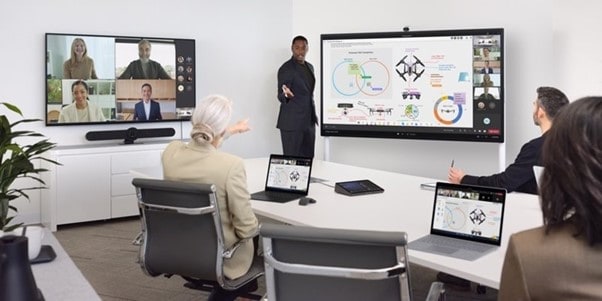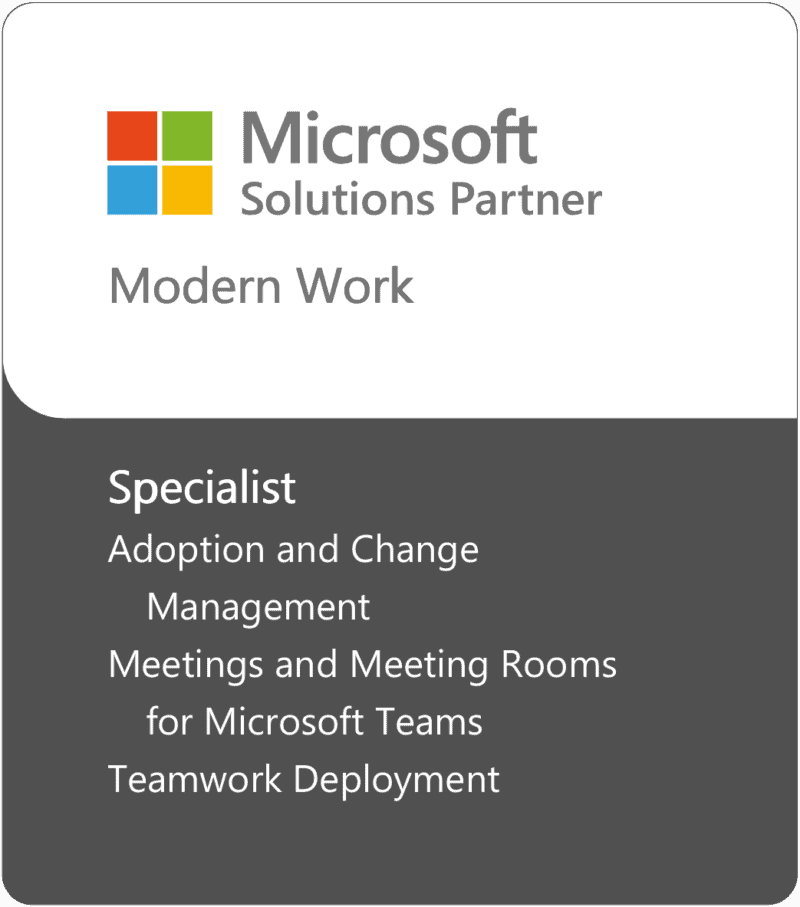Tech that follows: Digital Workplace solutions for the modern business
Getting the best from tech in the hybrid era of work. Embracing flexibility and different work styles is critical to the success of any business in today’s competitive market. Regardless of an organisation’s size, industry, location, or distribution, its people must be able to connect and collaborate with speed and ease. Which can be even harder now that we have the challenges of hybrid work to contend with. People are increasingly on the hunt for hybrid work opportunities too, with 53% of employees considering transitioning to a hybrid model in the year ahead. So, with numbers of dispersed employees on the rise, how do you ensure your organisation stays productive, and how do you make work, work? Another challenge is that for some, hybrid work is a business model that allows employees to work from home part-time, and in the office only a few times a month. While for others it means continuing with remote working. With such a loose definition, how can organisations ensure they’re meeting each individual employee’s need – no matter where and how they work? Put simply, adapting to inevitable workplace changes is crucial. Every business function will need to come together and reimagine how to empower employees, engage customers, optimise operations, and cultivate innovation. This means embracing the best agile workplace technology that will effectively, follow your people wherever they go. By connecting people with the tools and data they need to work from any location, the opportunity exists to achieve far greater levels of productivity, operational agility, and sustainability.
Without communication, teams can’t collaborate.
Enabling seamless, secure communication between workplaces is key to supporting a flexible, dynamic hybrid work model. This includes giving people the ability to manage their communications, without the need to be in the office. While many organisations already use video collaboration tools, today’s world of hybrid work demands more. Robust, reliable technology that offers an exceptional end user experience can help encourage adoption, along with solutions that ensure meeting equity for all. But beyond supporting remote connectivity, the bigger picture is about unifying workforce communications at the desk, in the corridor, or on the road. In other words, making unified communications (UC) work in a hybrid workplace. A good place to start is by creating a solid strategy for hybrid work UC, which covers the following key considerations:
What gaps exist in your UC environment?
How much bandwidth will you need?
What's needed to help smoothen the transition?
What end user training will you need?
How will you reduce IT support burden from different vendor solutions?
What do you do with existing or end of life meeting room technology?
Wherever your people go, your tech should follow.
Hybrid success demands an agile and responsive workforce, regardless of where people are and how they are connecting. Although seamless UC is a key factor in this equation, it is only one part of a journey. A hybrid strategy should also encompass the apps, data, and tools people need to do their best work. And because work is not about where you go but what you do, it’s imperative that employees receive a great digital experience that follows them wherever they access their applications. Apps are a great way to keep teams engaged whether they’re in the office or working remotely and offer the potential to greatly enhance the hybrid workplace experience. For example, collaboration apps designed to keep dispersed teams connected can help streamline workflow from home or in the office – not to mention saving costs associated with travel. In fact, Forrester reports that Microsoft Teams and Teams Room devices such as Surface Hub can save an average of 40% of an organisation’s travel budget . With a comprehensive and unified communications platform, employees can chat online, plan meetings, call or video chat, and share files and calendars from any device with other remote colleagues. And with the right apps, IT teams can help the business realise a whole host of other benefits, such as:
- Standardised, more secure device experiences from any location
- Barrier-free collaboration between remote and in-office employees
- Simplified, modern ways to ensure inclusive and accessible meetings
- Accelerated onboarding, training, and career growth
- Resilient connections to company, mission, and coworkers
- Greater sense of wellbeing from improved productivity, collaboration, and job satisfaction
- Automated processes that improve workflows and free up IT resources
To stay productive, employees must also be able to access documents, data, frameworks, and core business systems from any workplace, at any time. Done well, apps, digital tools, and automated processes can provide fast secure access, which also helps reduce recency bias and organisational silos. This has become profoundly important in the hybrid workplace, allowing organisations to get data into the hands of those who need, when they need it.
 |
Protecting against ever-evolving threat.Just as important as ensuring quick and easy data access is preventing information from falling into the wrong hands. Now more than ever, organisations of all sizes must ensure their data, apps and systems are protected against increasingly sophisticated cyber threats. The vast increase in remote working during the pandemic led to a 600% increase in cybercrime. Furthermore, 667 million new malware detections were discovered worldwide in 2020 . In a hybrid world where the workplace is anywhere, endpoints could be anything, and applications hosted everywhere, there comes an inevitable increase in these cyber-attack opportunities. To safeguard the business, IT teams would do well to consider integrated hardware, firmware, and software security, directly within the devices they deploy – rather than just software protection. Secure hybrid work is achieved when connectivity is fast, easy-to-use, and protects transactions wherever people and data go. All while ensuring the same, productive user experience regardless of where people are using technology. The dynamic nature of hybrid work also underlines the importance of having connectivity that supports scalable usage and flexibility, with devices, apps, and tools that adapts to different working styles and scenarios. |
From place to people: Changing the focus of work“Employee expectations are changing, and we will need to define productivity much more broadly — inclusive of collaboration, learning, and wellbeing to drive career advancement for every worker, including frontline and knowledge workers, as well as for new graduates and those who are in the workforce today. All this needs to be done with flexibility in when, where, and how people work.” Satya Nadella, CEO, Microsoft The rapid rise of the hybrid work model has changed the focus of work from place to people. It has also highlighted the need for digital equity, whereby all individuals have the technology and capability needed to perform at their best, from anywhere. In this age of hybrid work, organisations must choose agile workplace solutions that enable them to keep pace with ever-evolving employee and customer demand. The modern workplace is not only mobile, but also highly distributed. It requires a specific set of skill and tools to manage and meet employee expectation. All of which needs careful planning, and a properly devised deployment. At SCC we offer access to consultants with a depth of agile workplace expertise to help you maximise hybrid work efficiency. Our team of specialists can help you choose the best solutions that not only strengthen collaboration, but help you achieve a consistent sense of culture that improves retention, customer interaction, and alignment with your company mission. We’re all about partnership, with a focus on expanding your in-house capabilities and defining the strategy and vision around your next steps. We’d love to hear from you and understand where you are on your journey, so please get in touch for a chat about how we can help drive your business forward. |
 |
Fill out the form below to get in touch with one of our specialists to learn more… We may contact you by phone or email, if you have not opted out, or where we are otherwise permitted by law, to provide you with marketing communications about similar goods and services, the legal basis that allows us to use your information is ‘legitimate interests’. If you’d prefer not to hear from us you can unsubscribe here. More information about how we use your personal data can be found in our Privacy Policy.
For more information, please email [email protected] or visit www.scc.com |
Get in touch |
